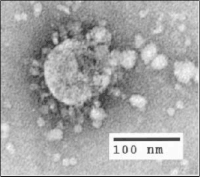
Reassessment of the Role of Race in Calculating the Risk for Urinary Tract Infection: A Systematic Review and Meta-analysis.
Sign Up to like & getrecommendations! Published in 2022 at "JAMA pediatrics"
DOI: 10.1001/jamapediatrics.2022.0700
Abstract: Importance A previously reported prediction model included a child's race to estimate risk of urinary tract infection (UTI), but race-conscious medicine encourages investigating how race is likely to be a proxy for other factors that… read more here.
Keywords: urinary tract; tract infection; race; black children ... See more keywords

Detection of PCT and urinary β2‐MG enhances the accuracy for localization diagnosing pediatric urinary tract infection
Sign Up to like & getrecommendations! Published in 2017 at "Journal of Clinical Laboratory Analysis"
DOI: 10.1002/jcla.22088
Abstract: The purpose of this article was to investigate whether the combination of urinary beta 2 microglobulin (urinary β2‐MG) and procalcitonin (PCT) diagnosis could enhance the localization diagnostic precision of pediatric urinary tract infection comparing with… read more here.
Keywords: urinary tract; pct; localization; pediatric urinary ... See more keywords

Significance of sonographically detected bladder debris in children less than 2 years old with febrile urinary tract infection
Sign Up to like & getrecommendations! Published in 2020 at "Journal of Clinical Ultrasound"
DOI: 10.1002/jcu.22964
Abstract: To investigate the relationship between bladder debris found on renal and bladder ultrasonography (RBUS) and the first febrile urinary tract infection (UTI) episode in children under 2 years old. read more here.
Keywords: urinary tract; years old; bladder; febrile urinary ... See more keywords

Experiences of urinary tract infection: A systematic review and meta‐ethnography
Sign Up to like & getrecommendations! Published in 2022 at "Neurourology and Urodynamics"
DOI: 10.1002/nau.24884
Abstract: To understand the experience of urinary tract infection (UTI) by synthesizing primary qualitative research findings and developing a conceptual model that illustrates this experience. read more here.
Keywords: urinary tract; tract infection; experiences urinary; infection systematic ... See more keywords

Respiratory sequelae and quality of life in children one‐year after being admitted with a lower respiratory tract infection: A prospective cohort study from a developing country
Sign Up to like & getrecommendations! Published in 2019 at "Pediatric Pulmonology"
DOI: 10.1002/ppul.24598
Abstract: Respiratory tract infections in children can result in respiratory sequelae. We aimed to determine the prevalence of, and factors associated with persistent respiratory sequelae 1 year after admission for a lower respiratory tract infection (LRTI). read more here.
Keywords: lower respiratory; respiratory sequelae; respiratory tract; year ... See more keywords

Is viral coinfection a risk factor for severe lower respiratory tract infection? A retrospective observational study
Sign Up to like & getrecommendations! Published in 2021 at "Pediatric Pulmonology"
DOI: 10.1002/ppul.25422
Abstract: To determine whether viral coinfection is a risk for severe lower respiratory tract infection (LRTI). read more here.
Keywords: severe lower; lower respiratory; viral coinfection; respiratory tract ... See more keywords

A micro-Raman and chemometric study of urinary tract infection-causing bacterial pathogens in mixed cultures
Sign Up to like & getrecommendations! Published in 2019 at "Analytical and Bioanalytical Chemistry"
DOI: 10.1007/s00216-019-01784-4
Abstract: AbstractDetection of urinary tract infection (UTI)-causing bacteria uses conventional time-consuming microbiological techniques. The current need is to use a fast and reliable method of bacterial identification. In order to unambiguously distinguish the UTI-causing five bacterial… read more here.
Keywords: urinary tract; tract infection; study; micro raman ... See more keywords

Innate immunity and urinary tract infection
Sign Up to like & getrecommendations! Published in 2019 at "Pediatric Nephrology"
DOI: 10.1007/s00467-019-04269-9
Abstract: Urinary tract infections are a severe public health problem. The emergence and spread of antimicrobial resistance among uropathogens threaten to further compromise the quality of life and health of people who develop acute and recurrent… read more here.
Keywords: urinary tract; tract infection; innate immunity; tract ... See more keywords

Defining urinary tract infection by bacterial colony counts: a case for 100,000 colonies/ml as the best threshold
Sign Up to like & getrecommendations! Published in 2019 at "Pediatric Nephrology"
DOI: 10.1007/s00467-019-04283-x
Abstract: Urinary tract infections (UTIs) are common in childhood and cause a considerable health burden. Though many children have mild symptoms and are easily treated, some present severely unwell with urosepsis. UTIs may be associated with… read more here.
Keywords: infection bacterial; urinary tract; defining urinary; bacterial colony ... See more keywords

Defining urinary tract infection by bacterial colony counts: a case for less than 100,000 colonies/mL as the threshold
Sign Up to like & getrecommendations! Published in 2019 at "Pediatric Nephrology"
DOI: 10.1007/s00467-019-04291-x
Abstract: Many basic issues on making an accurate diagnosis of a urinary tract infection (UTI) are controversial still today. This might come as a surprise as UTIs are one of the most common bacterial infections in… read more here.
Keywords: urinary tract; tract infection; colony; defining urinary ... See more keywords

Evaluation of Antimicrobial Peptides at the Diagnosis of Urinary Tract Infection in Children
Sign Up to like & getrecommendations! Published in 2020 at "International Journal of Peptide Research and Therapeutics"
DOI: 10.1007/s10989-020-10083-x
Abstract: Aim of study was evaluation of urine levels of HD5 and HNP 1–3 at diagnosis of urinary tract infection (UTI) in children. Forty-two urine samples with positive urine culture were patient group whereas 46 urine… read more here.
Keywords: diagnosis urinary; tract infection; urinary tract; patient ... See more keywords